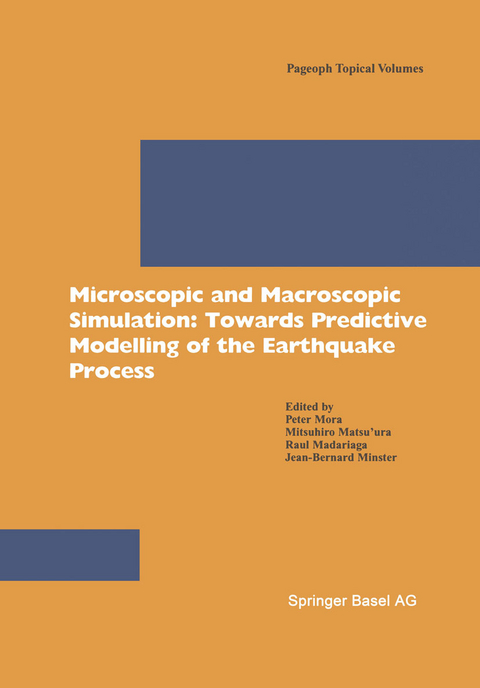Microscopic and Macroscopic Simulation: Towards Predictive Modelling of the Earthquake Process
Springer Basel (Verlag)
978-3-7643-6503-5 (ISBN)
Microscopic Simulation.- Numerical Simulation of Localisation Phenomena in a Fault Zone.- Shear Heating in Granular Layers.- Extension of the Lattice Solid Model to Incorporate Temperature Related Effects.- Hybrid Modelling of Coupled Pore Fluid-solid Deformation Problems.- Numerical Simulation of Rock Failure and Earthquake Process on Mesoscopic Scale.- Damage Localization as a Possible Precursor of Earthquake Rupture.- Evolution-induced Catastrophe and its Predictability.- Macroscopic Simulation: Short Time Scale Phenomena (Rupture and Strong Motion).- Dynamic Propagation and Interaction of a Rupture Front on a Planar Fault.- Criticality of Rupture Dynamics in 3-D.- Spontaneous Rupture Propagation on a Non-planar Fault in 3-D Elastic Medium.- Constraints on Stress and Friction from Dynamic Rupture Models of the 1994 Northridge, California, Earthquake.- Parallel 3-D Simulation of Ground Motion for the 1995 Kobe Earthquake: The Component Decomposition Approach.- Computer Simulation of Strong Ground Motion near a Fault Using Dynamic Fault Rupture Modeling: Spatial Distribution of the Peak Ground Velocity Vectors.- Numerical Simulation of Dynamic Process of the Tangshan Earthquake by a New Method-LDDA.- Nonlinear Structural Subsystem of GeoFEM for Fault Zone Analysis.- Macroscopic Simulation: Long Time Scale Phenomena (Earthquake Cycle).- 3-D Physical Modelling of Stress Accumulation Processes at Transcurrent Plate Boundaries.- The Edges of Large Earthquakes and the Epicenters of Future Earthquakes: Stress-induced Correlations in Elastodynamic Fault Models.- Precursory Seismic Activation and Critical-point Phenomena.- Evolution of Stress Deficit and Changing Rates of Seismicity in Cellular Automaton Models of Earthquake Faults.- Accelerating Seismic Energy Release andEvolution of Event Time and Size Statistics: Results from Two Heterogeneous Cellular Automaton Models.- The Plausibility of Long-wavelength Stress Correlation or Stress Magnitude as a Mechanism for Precursory Seismicity: Results from Two Simple Elastic Models.- Scaling, Data Assimilation and Forecasting.- Scale-dependence in Earthquake Processes and Seismogenic Structures.- A Physical Scaling Relation Between the Size of an Earthquake and its Nucleation Zone Size.- Regional Difference in Scaling Laws for Large Earthquakes and its Tectonic Implication.- Continuous GPS Array and Present-day Crustal Deformation of Japan.- Implications of a Statistical Physics Approach for Earthquake Hazard Assessment and Forecasting.- Application of Linked Stress Release Model to Historical Earthquake Data: Comparison between Two Kinds of Tectonic Seismicity.- Development of a New Approach to Earthquake Prediction: Load/Unload Response Ratio (LURR) Theory.
| Erscheint lt. Verlag | 1.1.2001 |
|---|---|
| Reihe/Serie | Pageoph Topical Volumes |
| Zusatzinfo | VII, 567 p. 435 illus. |
| Verlagsort | Basel |
| Sprache | englisch |
| Maße | 170 x 244 mm |
| Gewicht | 1100 g |
| Themenwelt | Naturwissenschaften ► Biologie ► Ökologie / Naturschutz |
| Naturwissenschaften ► Geowissenschaften ► Geologie | |
| Naturwissenschaften ► Geowissenschaften ► Geophysik | |
| Schlagworte | City • Deformation • Development • Earthquake • Earthquake Prediction • Energy • fault zone • Formation • Hazard • Seismic • seismogenic • Simulation • Smog • Statistics • Temperature |
| ISBN-10 | 3-7643-6503-X / 376436503X |
| ISBN-13 | 978-3-7643-6503-5 / 9783764365035 |
| Zustand | Neuware |
| Haben Sie eine Frage zum Produkt? |
aus dem Bereich




